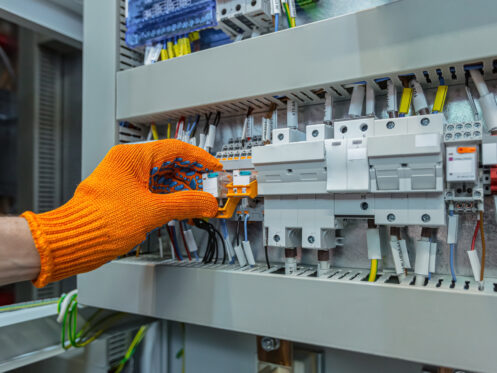Electrical safety is crucial in every home, but it’s often overlooked until a problem arises. By understanding the most common electrical repairs and how to avoid them, you can significantly mitigate risks, enhancing home safety and efficiency. Read on to better understand your home’s electrical needs and how to fortify your living space against potential electrical hazards.
1. Flickering Lights
Depending on its severity and frequency, this phenomenon can range from mildly annoying to downright disruptive. Many factors can cause flickering lights. One of the most common causes is a loose or defective light bulb. In such a case, flickering happens when the bulb is not properly fitted into the bulb holder, causing intermittent contact. Other causes could be more complex and concerning. These include issues with the voltage in your home, problems with your electrical circuits, or fluctuations in the power grid.
Flickering lights can also be symptomatic of loose or outdated wiring. However, it’s common to experience flickering when high-power devices or appliances like air conditioners or heaters are switched on, attributable to the abrupt increase in electrical demand.
To solve this issue, start by investigating simple causes. Consider replacing the affected bulb if the flickering is confined to a single light fixture. When the flickering is consistent across multiple lights, this could indicate a problem with your electrical circuit or overall electrical system. At this point, it’s advisable to stop further troubleshooting and contact a licensed electrician to properly diagnose the problem. Remember, dealing with electrical issues is a dangerous process. They should always be approached by an experienced electrician.
2. Strange Sounds
Strange sounds emanating from your electrical system are a common issue that shouldn’t be overlooked. These sounds may take the form of buzzing, humming, or crackling and are often indicative of serious underlying electrical issues. These noises could originate from various sources, such as outlets, light switches, circuit breakers, or even light fixtures. The sounds are most noticeable when electricity is being used.
The source of these sounds usually involves electricity arcing, which is electricity jumping across the gap in a circuit or between wires. This is not normal and can be dangerous. A loose or outdated outlet might cause arcing when you plug in or unplug a device, resulting in a crackling or buzzing sound. Similarly, a damaged or loose wire in a light switch can cause a buzzing sound when the switch is flipped. A circuit breaker can also emit a humming noise if it’s overloaded and struggling to handle the electrical load, causing the internal components to vibrate.
A certified electrician has the expertise to accurately diagnose the source of the sound and can safely rectify the issue. The technician might need to tighten a loose connection, replace outdated outlets or switches, or repair damaged wiring to stop the arcing. Addressing these sound issues not only resolves the noise annoyance but also mitigates potential fire hazards.
3. Tripping Circuit Breakers
Circuit breakers guard your home’s electrical system. They protect your wiring by tripping or ‘breaking’ the flow of electricity when necessary. Tripped circuit breakers often occur due to two primary reasons: overloads and short circuits. Overloads happen when too many appliances or devices draw power from the same circuit simultaneously, exceeding its carrying capacity.
On the other hand, short circuits occur when a hot (live) wire comes into contact with a neutral wire, causing a sudden surge of electricity that the circuit cannot handle. These scenarios typically arise during periods of high electrical usage, such as during the holiday season when you might have extra lights and appliances running or when multiple high-energy appliances are operating simultaneously.
An electrician can ascertain if the issue is due to overload, in which case the solution involves redistributing your electrical devices across multiple circuits or upgrading your electrical panel to accommodate a greater load. If a short circuit is the culprit, the electrician would locate the problematic wires and rectify the wiring problem. In some cases, recurring trips could be due to a faulty breaker, which would need replacing.
4. Electrical Shocks
The cause of electrical shocks in the home can be attributed to many factors. Faulty appliances, damaged wiring, improper grounding, and even high humidity can lead to these potentially dangerous incidents. Homeowners often report feeling shocks when they touch their electrical panel or an improperly grounded appliance.
An experienced electrician can identify the source of the problem by using specialized equipment to test different components of the home’s electrical system. Once the cause is identified, whether it’s a faulty appliance, a ground fault, or a wiring issue, the electrician can make the necessary repairs or replacements.
5. Outdated Wiring
Outdated wiring is a common yet often overlooked electrical repair issue. As homes age, so do their electrical systems. Initially, these systems may have been up to code and operating efficiently, but as time passes and technology advances, older systems can become inadequate and unsafe. Older wiring methods, such as knob-and-tube or ungrounded systems, may not be capable of handling the increased electrical load of modern homes, leading to overheating, fires, and electrocution risks.
Outdated wiring can also cause frequent circuit breaker trips, flickering lights, and burned electrical outlets. Upgrading to plastic-jacketed wiring and a three-wire system provides a safer and more efficient electrical setup for modern appliances and electronic devices.
6. Blackouts
Power outages can occur for several reasons, including overloaded power grids, weather-related incidents, or issues with the local power company. Installing a home generator is one effective solution to mitigate the impact of blackouts. Home generators are a reliable backup power source when the primary power grid fails. The generator can be powered by various fuels, such as natural gas, liquid propane, or diesel, and comes in different capacities to suit different home sizes and power requirements.
It’s worth noting that the installation process involves intricate wiring work to connect the generator safely to your home’s electrical system. Moreover, the generator must be correctly sized to meet your home’s power needs without overloading its capacity. We recommend contacting a local electrician to learn more about home generators and how the installation process.
7. Faulty Sockets and Switches
The primary cause of faulty outlets is often internal wiring problems, where the wires connected to the sockets or switches are either loose, damaged, or improperly connected. Other factors can include poor installation processes initially. A professional electrician can fix faulty sockets and switches by diagnosing the issue, securing loose connections, or replacing the damaged component.
Contact Your Local Certified Technician Today
Are you experiencing electrical issues in your home and need a trusted professional’s help? If you’re in Media, PA, or the surrounding areas, we’re here to serve you. Our certified technicians specialize in electrical repairs and installations, rewiring, inspections, home generator setups, and EV charger installation. We also offer plumbing repair and installation, as well as heating and cooling services. Contact Dream Team Home Services today and let us bring safety, efficiency, and peace of mind back into your home.



